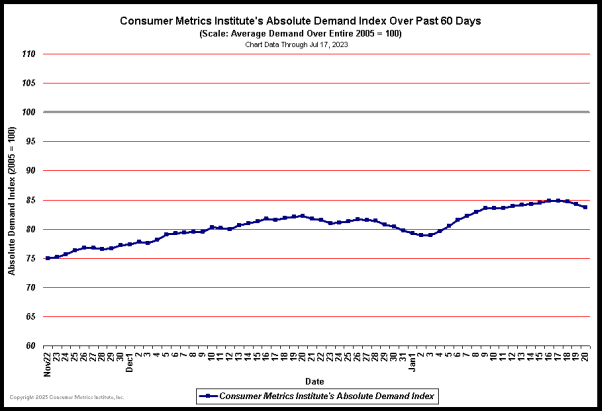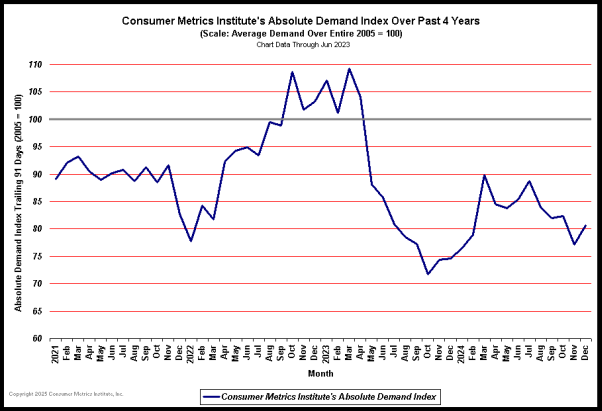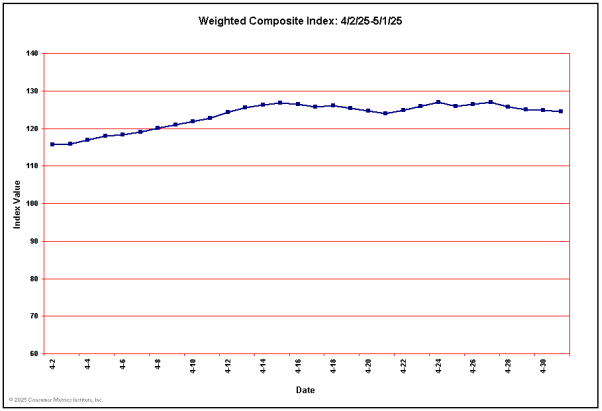 | October 26, 2023 - BEA Reports that Third Quarter 2023 GDP Grew at a 4.89% Rate:
In their first (preliminary) estimate of the US GDP for the third quarter of 2023, the Bureau of Economic Analysis (BEA) reported that the US economy was growing at a +4.89% annual rate, up 2.83 percentage points (pp) from the prior quarter.
Although the economy appears to be growing at a healthy rate, the headline number is seriously and optimistically misleading -- that number is halved when the impact of inventory building and the BEA's under estimation of inflation are properly considered. Additionally, the growth in consumer spending is not fueled by increasing household disposable income; it is instead largely funded from decreased savings rates.
In an earlier release, annualized household disposable income was reported to be $196 lower than in the prior quarter, and the household savings rate was reported to be 3.8%, down 0.6pp from the prior quarter.
For this estimate the BEA assumed an effective annualized deflator of 3.48%. During the same quarter the inflation recorded by the Bureau of Labor Statistics (BLS) in their CPI-U index was higher at 4.88%. Under estimating inflation results in optimistic growth rates, and if the BEA's nominal data was deflated using CPI-U inflation information the headline growth number would have been 3.67%.
Among the notable items in the report :
-- Consumer spending for goods was reported to be growing at a 1.08% rate, up 0.97pp from the prior quarter.
-- The contribution to the headline from consumer spending on services was reported to be 1.62%, up 1.18pp from the prior quarter. The combined consumer contribution to the headline number was 2.70%, up 2.15pp from the prior quarter.
-- The headline contribution for commercial/private fixed investments was reported to be 0.15%, down 0.75pp from the prior quarter.
-- Inventories added 1.32% to the headline number. It is important to remember that the BEA's inventory numbers are exceptionally noisy (and susceptible to significant distortions/anomalies caused by commodity pricing or currency swings) while ultimately representing a zero reverting (and long term essentially zero sum) series.
-- The contribution to the headline from governmental spending was reported to be 0.79%, up 0.22pp from the prior quarter.
-- The contribution from exports was reported to be 0.68%, up 1.77pp from the prior quarter.
-- Imports subtracted 0.75% annualized 'growth' from the headline number, down 1.88pp from the prior quarter. Foreign trade contributed a net -0.07pp to the headline number.
-- The annualized growth in the 'real final sales of domestic product' was reported to be 3.57%, up 1.51pp from the prior quarter. This is the BEA's 'bottom line' measurement of the economy (and it excludes the inventory data).
-- As mentioned above, real per-capita annualized disposable income was reported to have decreased by $196 quarter to quarter. The annualized household savings rate was 3.8% (down 0.6pp from the prior quarter). In the 61 quarters since 2Q-2008 the cumulative annualized growth rate for real per-capita disposable income has been 1.35%.
The Numbers
As a quick reminder, the classic definition of the GDP can be summarized with the following equation :
GDP = private consumption + gross private investment + government spending + (exports - imports)
or, as it is commonly expressed in algebraic shorthand :
GDP = C + I + G + (X-M)
In the new report the values for that equation (total dollars, percentage of the total GDP, and contribution to the final percentage growth number) are as follows :
GDP Components Table | | Total GDP | = | C | + | I | + | G | + | (X-M) | | Annual $ (trillions) | $27.6 | = | $18.7 | + | $4.9 | + | $4.8 | + | $-.8 | | % of GDP | 100.00% | = | 67.82% | + | 17.74% | + | 17.28% | + | -2.84% | | Contribution to GDP Growth % | 4.89% | = | 2.70% | + | 1.47% | + | 0.79% | + | -0.07% |
The quarter-to-quarter changes in the contributions that various components make to the overall GDP can be best understood from the table below, which breaks out the component contributions in more detail and over time. In the table below we have split the "C" component into goods and services, split the "I" component into fixed investment and inventories, separated exports from imports, added a line for the BEA's "Real Final Sales of Domestic Product" and listed the quarters in columns with the most current to the left :
Quarterly Changes in % Contributions to GDP | | Q3-2023 | Q2-2023 | Q1-2023 | Q4-2022 | Q3-2022 | Q2-2022 | Q1-2022 | Q4-2021 | Q3-2021 | Q2-2021 | Q1-2021 | Q4-2020 | | Total GDP Growth | 4.89% | 2.06% | 2.25% | 2.56% | 2.66% | -0.56% | -1.97% | 6.96% | 3.31% | 6.22% | 5.25% | 4.22% | | Consumer Goods | 1.08% | 0.11% | 1.14% | -0.01% | -0.18% | -0.09% | -0.30% | 1.26% | -2.10% | 3.24% | 3.52% | 0.71% | | Consumer Services | 1.62% | 0.44% | 1.40% | 0.80% | 1.23% | 1.41% | 0.27% | 1.45% | 3.99% | 5.49% | 2.18% | 2.92% | | Fixed Investment | 0.15% | 0.90% | 0.53% | -0.99% | -0.79% | -0.05% | 1.23% | 0.35% | -0.28% | 1.05% | 1.63% | 2.55% | | Inventories | 1.32% | 0.00% | -2.22% | 1.61% | -0.66% | -2.05% | -0.07% | 4.28% | 2.99% | -1.89% | -2.08% | -0.18% | | Government | 0.79% | 0.57% | 0.82% | 0.90% | 0.49% | -0.34% | -0.52% | -0.04% | -0.26% | -0.80% | 1.04% | -0.35% | | Exports | 0.68% | -1.09% | 0.76% | -0.41% | 1.80% | 1.19% | -0.50% | 2.42% | 0.16% | 0.20% | 0.06% | 2.31% | | Imports | -0.75% | 1.13% | -0.18% | 0.66% | 0.77% | -0.63% | -2.08% | -2.76% | -1.19% | -1.07% | -1.10% | -3.74% | | Real Final Sales | 3.57% | 2.06% | 4.47% | 0.95% | 3.32% | 1.49% | -1.90% | 2.68% | 0.32% | 8.11% | 7.33% | 4.40% |
Summary and Commentary
The key points of this report can be summarized as follows:
-- After factoring in the growth of inventories and the BEA's under estimation of inflation, these numbers actually look very similar to those of the prior quarter.
-- As a consequence, setting the optimistic headline aside, the economy is probably growing at a relatively healthy +2.5% rate. That is a lily that needs not be gilded.
-- All that said, households are probably not as healthy as consumer spending levels might indicate.
-- In late September the BEA did a comprehensive revision of its historical data back through 2017, and shifted its constant-dollar reference year from 2012 to 2017. The net impact of the revisions was an average change in annualized headline growth rates of +0.0843 percentage points. Most of that upside revision resulted from persistent under reporting of commercial/private fixed investments.
Please note that this will be our final report analyzing BEA GDP releases. It is time to ride off into the sunset. We want to thank our regular readers for their support over the past 15+ years, and we wish them (and the US economy) the very best in the future.
| |


